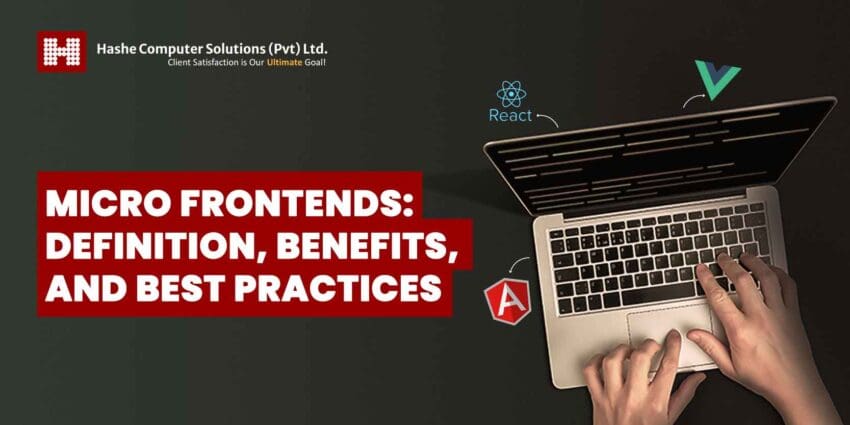
Developing feature-rich and user-friendly web applications has taken precedence in the rapidly evolving field of web development. Nevertheless, traditional development methodologies have encountered difficulties as applications become larger and more complicated. The answer is “micro frontends,” which provide web applications’ front ends more scalability and agility.
By dividing monolithic frontend applications into smaller, more manageable components, this technique encourages the independent creation, testing, and deployment of each user interface component. This architecture is transforming the way businesses build flexible, future-proof digital solutions by enabling faster feature rollouts, higher-quality code, and progressive modernization.
This article will discuss micro frontends, their fundamental concepts, varieties, and more. Now, let’s get started!
What are Micro Frontends?
The term “micro frontends” first appeared in the 2016 ThoughtWorks Technology Radar guide. This guide brings to light new developments and trends in software development that attract professionals in the field.
Micro frontends, an innovative architectural technique, include dividing a large frontend application into smaller, more manageable components. Fundamentally, micro frontends apply the microservices concept to the front end of web applications, which revolutionized backend development. Microservices are a well-known architectural pattern that divides the backend into discrete services, each accountable for a unique purpose.
Micro frontends divide a web application into more manageable, independent modules or functions by applying the same concepts to the front end. Since each module can be developed separately, frontend teams can work with flexibility and speed comparable to what backend teams can achieve with microservices.
In a micro frontend architecture, every component or page that makes up the user interface (UI) is designed, tested, and deployed separately. Different teams frequently own these components, which can independently function while contributing to a cohesive whole.
Key Concepts of Micro Frontends
Understanding the two fundamental principles of micro frontends is essential to their successful implementation.
Independent Development
With micro frontends, development teams may operate autonomously within larger projects. Every micro frontend module functions independently, focusing on a particular feature or function.
It offers the following benefits.
Faster Iterations: Development can proceed more quickly when teams can independently iterate and release changes.Reduced Bottlenecks: The entire development pipeline becomes more efficient when there are fewer inter-team dependencies.Specialized Expertise: Developers may polish their skills and become specialists in their micro frontend domain, promoting creativity and innovation.
Module Autonomy
The goal of each module is to be independent and self-sufficient. These modules do not depend on other application parts to perform correctly. This level of autonomy applies to both the development and operation of micro frontends.
It offers the following benefits.
- Separate Issue Handling: If one module experiences problems or requires upgrades, it can be fixed without jeopardizing the app’s overall stability.
- Improved scalability: Micro frontends’ modular design facilitates the scalability of individual components in response to rising demand.
- Technological stack flexibility: Teams are not limited by decisions made elsewhere in the application to choose the best technology stack for their micro frontend.
Advantages of Micro Frontends
Following are some of the key benefits of micro frontends.
Autonomy
Micro frontends allow distinct teams to work autonomously on separate components, utilizing the technology stack best suited to their component’s requirements. This independence enables parallel development, reducing project timeframes, fostering creativity, and boosting overall productivity.
Scalability
The micro frontend architecture enables the division of applications into more manageable, standalone components. Teams can concentrate on developing particular components without having to understand the entire codebase, facilitating higher scalability.
Ease of Deployment
The framework allows for more frequent and isolated deployments because of its independent nature. It allows for faster feature roll-outs and reduces the risk associated with deploying changes to a massive, monolithic application.
Optimized Loading
Monolithic apps often load the whole codebase, including parts the user may not require right away. Micro frontends, on the other hand, load particular modules as needed. This improved loading decreases initial loading times, contributing to a faster and more seamless user experience.
Efficient Maintenance
Maintaining smaller, self-contained units is easier. It allows developers to work on the individual micro frontend without impacting the overall app in case of problems or when improvements are needed.
Resilience
Micro frontends provide a reliable and resilient architecture. If there are problems with one module or it needs maintenance, the application can still work as a whole. This is especially important for large-scale applications with several independent functionalities.
Enhanced User-Experience
Micro frontends’ dependability improves user experience. Even while particular modules receive upgrades or maintenance, users can still use the unaffected portions of the app.
Modernization
The micro frontend framework allows an organization to modernize its applications incrementally by allowing each component to be upgraded or replaced. It lowers the risks involved in major redesigns and enables businesses to integrate new technology at their own pace.
Disadvantages of Micro Frontends
Though there are many benefits to this architecture, it is important to consider its unique challenges and potential downsides.
Increased Complexity
The micro frontend architecture may add complexity because of the necessity for inter-component communication, diverse technology stacks, and the coordination of numerous deployment pipelines. It might lead to additional costs for team collaboration and architectural planning.
Consistency Challenges
Keeping the user interface and experience consistent across several independently produced components can be challenging. A cohesive and consistent end-user experience necessitates strict adherence to design rules and frequent team communication.
Potential Performance Impact
Performance problems may arise from the implementation of the micro frontend architecture. The application’s overall size and load time may increase due to loading several frameworks or libraries for various components.
Operational Overhead
The framework’s autonomous component deployment, scaling, and monitoring may necessitate additional infrastructure and management work. Resources and operational costs may rise as a result of this.
Shared Component Management
It can be difficult to share common features or components amongst several sections, and doing so may require creating and managing a shared components library, which adds another administrative burden.
Types of Micro Frontends
Monorepository
Under this setup, a single repository houses all micro frontend projects.
It may seem to go against the idea of micro frontends, which aims to create separate projects and then integrate them later. However, in this instance, all the projects are contained under a single system of dependencies and subfolders for every project.
An instance of this kind of micro frontend is the one that Angular provides by default for internally generating sub-applications.
Multirepository
Every micro frontend project under the multirepository technique resides in a different repository. This approach involves isolating the projects, with each project having its own separate dependency system.
Metarepository
This approach aims to achieve a balance between monorepositories and multirepositories. It entails maintaining separate repositories for each micro frontend while combining them into a single central repository.
When to Use Micro Frontends
When the following circumstances or requirements occur, micro frontends are a wise architectural decision since they are especially well-suited for particular scenarios and application types.
Large Apps with Multiple Functions
The frontend might get more complicated in large-scale applications since it has to handle more features and functionalities. Micro frontends divide the program into smaller, easier-to-handle components to better manage this complexity.
Furthermore, applications frequently run into scalability issues as they get larger. Micro frontends provide an answer by letting you scale individual components separately so your application runs smoothly and stays responsive.
Isolated Function Sets
When segmenting an application into discrete functional groups is evident, micro frontends work exceptionally well. Micro frontends enable you to design distinct modules for different functionalities within your online application, like a smartphone with apps for various tasks.
Another scenario is the specialized teams for particular modules. Micro frontends let your development teams take charge of a particular module if they have particular expertise or areas of focus. This specialization encourages creativity and guarantees that the best team handles every facet of the application.
Diverse Technology Stack
Micro frontends allow flexibility in selecting technological stacks. Different modules can be created utilizing the technologies that best meet their individual needs. Because of its flexibility, you can use various frameworks and libraries’ advantages in a single application.
The ability to leverage a variety of tech stacks can help make hiring procedures easier. New developers can quickly fit into teams that complement their skill sets and form teams based on specialized technological knowledge.
Collaboration Across Teams
Micro frontends allow teams to work together while still being autonomous. Teams may operate on separate modules without interference, eliminating bottlenecks and boosting productivity.
Teams can collaborate more easily when there are defined module boundaries since they reduce the possibility of disagreements and codebase collisions.
Evolving Business Requirements
Micro frontends facilitate an iterative process in application development. You may continuously improve and expand your application without completely redesigning the coding, ensuring it remains flexible and competitive.
Micro Frontend Frameworks
React
React appears as a viable option for micro frontend development, owing to its effective rendering optimizations and the strength of the virtual DOM. Micro frontends are modular, and their component-based architecture fits that description perfectly.
Flexibility in incorporating new libraries and versions is a noteworthy benefit of React. This flexibility makes maintenance easier, enabling development teams to update React components progressively within micro frontends without disrupting the entire app.
Moreover, React offers a robust ecosystem of solutions, frameworks, and tools that can help improve the creation of micro frontends.
Angular
Angular’s well-defined and opinionated design makes it an excellent choice for micro frontends, particularly when paired with contemporary capabilities like Webpack 5’s Module Federation, introduced in Angular 12. Angular’s robust monorepos support is particularly useful for organizing and maintaining several small frontend projects in one repository.
Angular is an appealing option for teams aiming to guarantee a solid and organized development process because of its strong typing and ahead-of-time (AOT) compilation, which also help improve the maintainability and stability of micro frontends.
Next.js
Next.js, a production-ready React framework, provides a gradual adoption path for React. Therefore, it is a straightforward and effective option for micro frontend architecture. Next.js uses Webpack 5’s Module Federation functionality in micro frontend setups to guarantee smooth integration of micro frontends.
Beyond that, server-side rendering (SSR) is another area in which Next.js shines, and this is especially useful for smaller frontends that want to maximize SEO and provide quick initial page loads. The amalgamation of React’s capabilities with Next.js’ production-ready features offers an ideal basis for developing modular and scalable frontend frameworks.
Vue.js
The straightforward and adaptable Vue.js JavaScript framework is well-known for its progressive nature. Vue.js has various benefits when it comes to micro frontend development. Its component-based architecture fits micro frontends’ modular design perfectly. Each Vue component may function as a self-contained module, making it simple to design, test, and manage.
Additionally, well-known for being simple to integrate into already-existing projects, vue.js is advantageous in micro frontend setups. It features an expanding ecosystem of libraries and tools that can improve the creation of micro frontends, and it permits you to scale specific modules inside your micro frontend architecture flexibly.
Svelte
Svelte is a relatively new cutting-edge framework that takes a novel approach to frontend development. It optimizes runtime speed by compiling components to highly efficient JavaScript at build time, leading to lower bundle sizes.
Svelte is a fascinating option for micro frontend development because of its efficiency. Optimizing loading speeds in micro frontend architectures requires smaller bundle sizes.
Since Svelte prioritizes efficiency, its exceptional runtime performance results in quicker initial page loads and an enhanced user experience. Svelte promotes a component-centric development strategy, in which each component of a micro frontend is built separately and then compiled into efficient JavaScript modules.
Micro frontend applications can easily integrate it with other frameworks or modules thanks to its small runtime footprint. With its clear API and concise code, Svelte provides a developer-friendly experience that helps expedite development cycles for micro frontend teams.
Implementing Micro Frontend Architecture: Best Practices
Automation and a well-structured workflow are essential for successfully implementing micro frontend architecture. Teams can collaborate more successfully by clearly outlining roles, duties, and API contracts. The following is a summary of best practices that businesses can use to create a micro frontend architecture:
Organizing Workflow
The key to development is empowering your staff to deliver independently. Therefore, defining tasks, goals, and positions everyone can agree on is crucial. It is similarly critical to ensure that API contracts between teams are well-structured and consistent. These contracts define the desired behavior of your APIs, allowing for more efficient collaboration.
Your teams can work autonomously toward their goals once these foundations are in place. Furthermore, integrating business demands with modular delivery might help maximize the benefits of this approach. Even with a modular architectural system, you may risk underusing modularity if your business demands that all components be designated simultaneously, resulting in a monolithic organizational structure.
Adopting Automation
The micro frontend architecture needs build and deployment automation. You may find yourself stuck without it. Although this need may apply to all systems, it becomes even more crucial in highly modular architectures. Thus, investing in a solid CI/CD pipeline is vital.
Both multi-level testing and test automation are essential in this situation. Ensuring that architecture components move smoothly and don’t interfere with the production environment should be the primary goal of your testing procedure. Therefore, creating clear, automatically validated, and testable dependencies needs to be a top goal.
Avoiding the Excessive Use of Micro Frontends
Overapplication may result in excessive application fragmentation, potentially producing low-value components. Numerous guides can help determine the best size and elements for service. It can be detrimental to over-optimize.
Consider potential obstacles before partitioning. Modular systems, for example, require different testing approaches for every module. Therefore, applications that need independent deployment should be the priority. Micro frontend implementation is best suited for features that require gradual adaptation.
Choosing the optimal size for your micro frontends
Determining the right size reflects the considerations regarding sizing microservices. They must be proportionately balanced; if they are too big, your application will become unduly coupled; if they are too small, it will cause fragmentation. Finding equilibrium is essential.
There’s no one-size-fits-all rule, but the general rule should be that every micro frontend has a unique business function in isolation. For instance, while making different micro frontends for each icon on a menu bar is technically possible, it is often more reasonable to treat the entire menu bar as a single micro frontend.
Conclusion
The use of micro frontends in web development is a paradigm change that is in line with how contemporary apps are progressing. With the freedom to operate autonomously, these modular frontend designs promote creativity and agility among development teams. Micro frontends simplify complex applications into self-contained modules, which helps to improve performance, increase reliability, and speed up development cycles.
Micro frontends are at the forefront of architectural innovation as the need for flexible and scalable web applications grows. Using micro frontends can completely change the way you approach web development, whether you’re working on a large-scale project with multiple services or trying to remain flexible in the face of shifting requirements.
Thus, as you set out on your next web development project, keep in mind the potential of micro frontends to produce feature-rich, intuitive apps that can grow and change with the ever-evolving digital landscape.
Are you looking for the best IT providers for your IT projects? Look no further than Hashe! Hashe Computer Solutions is a leading IT solutions provider that offers world-class software, mobile application, web development, and digital marketing services. Contact us for the best web design solutions!
Keep following us for more tech news!
Check out our Social Media Pages:
- Facebook: https://www.facebook.com/hasheCS/
- Instagram: @hashe_official
- LinkedIn: https://pk.linkedin.com/company/hashe-computer-solutions
- Twitter: https://twitter.com/hashe
- Youtube: https://www.youtube.com/channel/UCay7eQtwoQ3ehoIesAxHDPw
- Pinterest: https://www.pinterest.com/hashecs/
- Threads: https://www.threads.net/@hashe_official
- Behance: https://www.behance.net/hashecs
Was this helpful?
Last Modified: October 7, 2024 at 10:42 am
37 views















